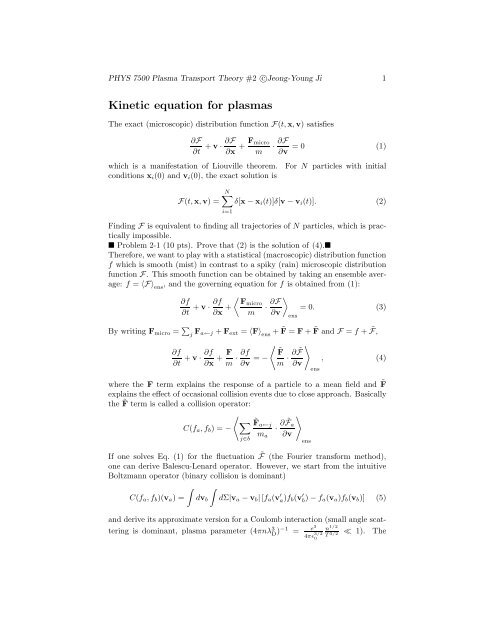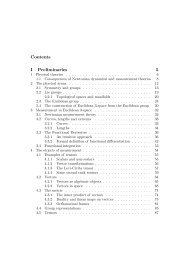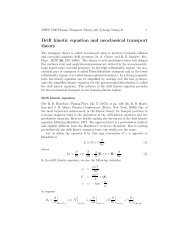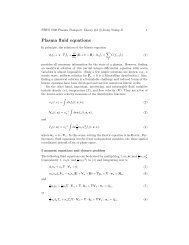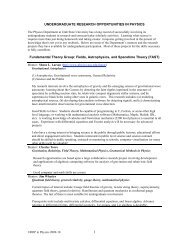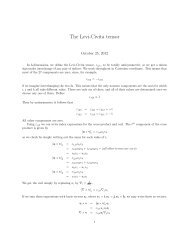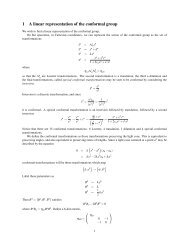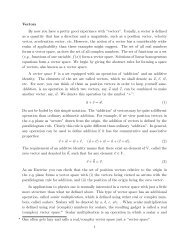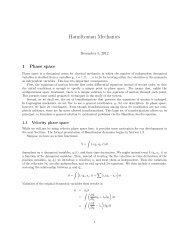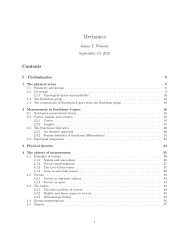Landau (Fokker-Planck) kinetic equation
Landau (Fokker-Planck) kinetic equation
Landau (Fokker-Planck) kinetic equation
You also want an ePaper? Increase the reach of your titles
YUMPU automatically turns print PDFs into web optimized ePapers that Google loves.
PHYS 7500 Plasma Transport Theory #2 c○Jeong-Young Ji 1<br />
Kinetic <strong>equation</strong> for plasmas<br />
The exact (microscopic) distribution function F(t,x,v) satisfies<br />
∂F<br />
∂t + v · ∂F<br />
∂x + F micro<br />
m · ∂F<br />
∂v = 0 (1)<br />
which is a manifestation of Liouville theorem. For N particles with initial<br />
conditions x i (0) and v i (0), the exact solution is<br />
F(t,x,v) =<br />
N∑<br />
δ[x − x i (t)]δ[v − v i (t)]. (2)<br />
i=1<br />
Finding F is equivalent to finding all trajectories of N particles, which is practically<br />
impossible.<br />
Problem 2-1 (10 pts). Prove that (2) is the solution of (4).<br />
Therefore, we want to play with a statistical (macroscopic) distribution function<br />
f which is smooth (mist) in contrast to a spiky (rain) microscopic distribution<br />
function F. This smooth function can be obtained by taking an ensemble average:<br />
f = 〈F〉 ens<br />
, and the governing <strong>equation</strong> for f is obtained from (1):<br />
∂f<br />
∂t + v · ∂f 〈<br />
∂x + Fmicro<br />
m · ∂F 〉<br />
= 0. (3)<br />
∂v<br />
ens<br />
By writing F micro = ∑ j F a←j + F ext = 〈F〉 ens<br />
+ ˜F = F + ˜F and F = f + ˜F,<br />
〈<br />
∂f<br />
∂t + v · ∂f<br />
∂x + F m · ∂f ˜F<br />
∂v = − m · ∂ ˜F<br />
〉<br />
, (4)<br />
∂v<br />
ens<br />
where the F term explains the response of a particle to a mean field and ˜F<br />
explains the effect of occasional collision events due to close approach. Basically<br />
the ˜F term is called a collision operator:<br />
〈 ∑ ˜F a←j<br />
C(f a , f b ) = −<br />
· ∂ ˜F<br />
〉<br />
a<br />
m a ∂v<br />
j∈b<br />
If one solves Eq. (1) for the fluctuation ˜F (the Fourier transform method),<br />
one can derive Balescu-Lenard operator. However, we start from the intuitive<br />
Boltzmann operator (binary collision is dominant)<br />
∫ ∫<br />
C(f a , f b )(v a ) = dv b dΣ|v a − v b | [f a (v a ′ )f b(v b ′ ) − f a(v a )f b (v b )] (5)<br />
and derive its approximate version for a Coulomb interaction (small angle scattering<br />
is dominant, plasma parameter (4πnλ 3 D )−1 n<br />
=<br />
1/2<br />
≪ 1). The<br />
T 3/2<br />
ens<br />
e3<br />
4πɛ 3/2<br />
0
PHYS 7500 Plasma Transport Theory #2 c○Jeong-Young Ji 2<br />
Boltzmann operator satisfies: (i) f is always nonnegative (ii) the operator conserves<br />
particle number, momentum, and energy (iii) ∫ dvf lnf is always decreasing<br />
(non-Maxwellian) or constant (Maxwellian for equilibrium). To summarize,<br />
the state of an ionized gas for plasma species a is described by a distribution<br />
function f a and its evolution is governed by the (approximate) Boltzmann <strong>equation</strong><br />
or <strong>Landau</strong>-<strong>Fokker</strong>-<strong>Planck</strong> <strong>equation</strong><br />
∂f a<br />
∂t + v · ∂f a<br />
∂x + F a<br />
m a<br />
· ∂f a<br />
∂v = ∑ b<br />
C(f a , f b ),<br />
where a and b stand for particle species, e.g., ions (i) and electrons (e).<br />
Rutherford scattering<br />
The scattering of a particle a by a target particle b with a Coulomb potential<br />
α<br />
r<br />
is given by (this is a good exercise to refresh your memory of sophomore<br />
physics)<br />
sin θ 2 = 1<br />
√<br />
1 + (ρ/ρ0 ) , (6)<br />
2<br />
where<br />
and<br />
ρ 0 =<br />
|α|<br />
m ab u2, (7)<br />
m ab =<br />
m am b<br />
,<br />
m a + m b<br />
(8)<br />
u = v a − v b . (9)<br />
Here ρ is the impact parameter, and θ is the scattering angle.<br />
Problem 2-2 (10 pts). Show from energy and momentum conservation that<br />
|u ′ | = |u| where u ′ = v a ′ − v b ′ is the relative velocity after the collision. <br />
In the target particle’s rest frame, the scattered velocity is<br />
u ′ = u(ˆxsin θ cosφ + ŷ sin θ sin φ + ẑ cosθ), (10)<br />
or<br />
u ′ = u + ∆u ‖ + ∆u ⊥ , (11)<br />
∆u ‖ = u(cos θ − 1) = uẑ(cosθ − 1), (12)<br />
∆u ⊥ = u(ˆxsin θ cosφ + ŷ sinθ sinφ) (13)<br />
where ‖ and ⊥ are parallel and perpendicular to u (the relative velocity before<br />
the collision). The differential cross section for a Coulomb interaction is<br />
dΣ<br />
dΩ = d(πρ2 )<br />
2π sinθdθ = −<br />
ρ<br />
sinθ<br />
dρ<br />
dθ = − ρ2 0<br />
4 sin 4 θ 2<br />
ρ 2 0<br />
= −<br />
(1 − cosθ) 2 . (14)
PHYS 7500 Plasma Transport Theory #2 c○Jeong-Young Ji 3<br />
It follows from the momentum conservation<br />
0 = m a ∆v a + m b ∆v b (15)<br />
that<br />
and<br />
∆v b = − m a<br />
m b<br />
∆v a (16)<br />
∆u = ∆v a − ∆v b = (1 + m a<br />
m b<br />
)∆v a = m a<br />
m ab<br />
∆v a = − m b<br />
m ab<br />
∆v b (17)<br />
Collision operator for Coulomb interaction<br />
The Boltzmann operator is difficult to calculate for the Coulomb interaction.<br />
Fortunately, the scattering cross section (14) for a large angle is extremely small<br />
compared to a small angle. Therefore, Taylor-expanding distribution functions<br />
after the collision in Eq. (5) in power of ∆v and retaining only terms through<br />
the second order, we obtain a practically tractable collision operator:<br />
C(f a , f b ) =<br />
∫<br />
dv b<br />
∫<br />
(<br />
dΣ|v a − v b |<br />
∆v a · ∂f a<br />
∂v a<br />
f b + f a ∆v b · ∂f b<br />
∂v b<br />
+ 1 2 ∆v ∂ ∂<br />
a∆v a : f a + ∆v a ∆v b : ∂f a ∂f b<br />
∂v a ∂v a ∂v a ∂v b<br />
+ 1 )<br />
2 f ∂ ∂<br />
a∆v b ∆v b : f b .<br />
∂v b ∂v b<br />
Using Eq. (17), we can write<br />
∫ [<br />
mab ∂f a<br />
C(f a , f b ) = dv b u ̂∆u · f b − m ab ∂f b<br />
f â∆u · )<br />
m a ∂v a m b ∂v b<br />
+ 1 2 (m ab<br />
m a<br />
) 2 ̂∆u∆u :<br />
+( m ab<br />
m b<br />
) 2 f a ̂∆u∆u :<br />
∂<br />
∂v a<br />
∂<br />
∂v b<br />
∂<br />
∂v a<br />
f a − m ab<br />
m a<br />
m ab<br />
̂∆u∆u : ∂f a ∂f b<br />
m b ∂v a ∂v<br />
]<br />
b<br />
∂<br />
f b , (18)<br />
∂v b<br />
where we have defined ̂∆u = ∫ dΣ∆u and ̂∆u∆u = ∫ dΣ∆u∆u.<br />
Calculation of velocity change<br />
Here we calculate<br />
Using Eq. (14),<br />
̂∆u =<br />
∫ ρmax<br />
0<br />
∫ ρmax<br />
dΣ∆u = u dΣ(cosθ − 1).<br />
0<br />
∫ θmin<br />
2πρ<br />
̂∆u 2 0<br />
= u d cosθ (cosθ − 1)<br />
π (1 − cosθ)<br />
2 θ min<br />
= 2πρ 2 0u ln(1 − cosθ)<br />
∣ ,<br />
π
PHYS 7500 Plasma Transport Theory #2 c○Jeong-Young Ji 4<br />
where θ min is the angle for ρ = ρ max = λ D . From (6),<br />
where<br />
Then<br />
1 − cosθ min<br />
2<br />
= sin 2 θ min<br />
2<br />
=<br />
1<br />
1 + Λ2, (19)<br />
Λ ab = λ D<br />
= λ Dm ab u 2<br />
≈ 3λ D m b T a + m a T b<br />
. (20)<br />
ρ 0 |α| |α| m a + m b<br />
̂∆u = −2πρ 2 0u ln(1 + Λ 2 ) ≈ −4πρ 2 0u ln Λ (Λ ≫1), (21)<br />
where ln Λ is called the Coulomb logarithm.<br />
Also, we calculate<br />
∫<br />
̂∆u∆u = dΣ∆u∆u<br />
∫<br />
= dΣ(∆u ‖ ∆u ‖ + ∆u ‖ ∆u ⊥ + ∆u ⊥ ∆u ‖ + ∆u ⊥ ∆u ⊥ ).<br />
From Eqs. (12) and (13), ∫ dΣ∆u ‖ ∆u ⊥ = 0, ∫ dΣ∆u ⊥ ∆u ‖ = 0,<br />
∫<br />
∫<br />
dΣ∆u ‖ ∆u ‖ = uu dΣ(cosθ − 1) 2<br />
and<br />
∫<br />
dΣ∆u ⊥ ∆u ⊥ =<br />
where we have used<br />
and<br />
Finally, we have<br />
∫ θmin<br />
= uu<br />
π<br />
2πρ 2 0<br />
d cosθ (cos θ − 1)2<br />
(1 − cosθ)<br />
2<br />
= 2πρ 2 0 uu(1 + cosθ min) = 4πρ 2 Λ2<br />
0uu 1 + Λ 2 ,<br />
∫<br />
−ρ 2 0<br />
dΩ<br />
(1 − cosθ) 2 u2 [ˆxˆx sin 2 θ cos 2 φ<br />
+(ˆxŷ + ŷˆx)sin 2 θ cosφsin φ + ŷŷ sin 2 θ sin 2 φ]<br />
= ρ 2 0 u2 ∫ θmin<br />
π<br />
d cosθ<br />
(1 − cosθ) 2 π(ˆxˆx + ŷŷ)sin2 θ<br />
= πρ 2 0 u2 (ˆxˆx + ŷŷ)[− 2Λ2<br />
1 + Λ 2 − 2 ln 1<br />
1 + Λ 2 ],<br />
1 + cosθ min = 2(1 − sin 2 θ 2 ) = 2(1 − 1<br />
1 + Λ 2 ) = 2Λ2<br />
1 + Λ 2 , (22)<br />
cosθ min = − 1 − Λ2<br />
1 + Λ 2 . (23)<br />
̂∆u∆u ≈ 4πρ 2 0 (u2 I − uu)ln Λ (Λ ≫ 1). (24)
PHYS 7500 Plasma Transport Theory #2 c○Jeong-Young Ji 5<br />
<strong>Landau</strong> collision operator<br />
Introducing the <strong>Landau</strong> tensor<br />
and its derivative<br />
U = u2 I − uu<br />
u 3 ,<br />
∂<br />
∂v a<br />
· U = − 2u<br />
u 3 ,<br />
we can write Eqs. (21) and (24), respectively, as<br />
and<br />
̂∆u ≈ −4π α2 ln Λ<br />
m 2 u = γ abm a 1 ∂<br />
ab u4 2m 2 · U, (25)<br />
ab<br />
u ∂v a<br />
̂∆u∆u ≈<br />
4π α2 ln Λ U<br />
m 2 ab<br />
u = γ abm a U<br />
m 2 ab<br />
u , (26)<br />
where<br />
γ ab = 4πα2 ln Λ ab<br />
m a<br />
= q2 a q2 b ln Λ ab<br />
4πɛ 2 0 m .<br />
a<br />
Let’s write Eq. (18) term by term (t i denotes the ith term and t ij denotes the<br />
jth term in t i )<br />
t 1 = γ ∫ (<br />
ab ∂ 1 ∂f a<br />
dv b · U · f b + 1 )<br />
∂f a<br />
f b = t 11 + t 12 ,<br />
2 ∂v a m a ∂v a m b ∂v a<br />
t 2 = γ ∫ (<br />
ab ∂<br />
dv b · U · − 1 ∂f b<br />
f a − m )<br />
a ∂f b<br />
2 ∂v a m b ∂v b m 2 f a = t 21 + t 22 ,<br />
b<br />
∂v b<br />
t 3 = γ ∫<br />
ab 1 ∂ ∂f a<br />
dv b U : f b ,<br />
2 m a ∂v a ∂v a<br />
t 4 = − γ ∫<br />
ab 2<br />
2 m b<br />
= γ [ ∫<br />
ab 1<br />
−<br />
2 m b<br />
= t 41 + t 42 ,<br />
dv b U : ∂f a<br />
∂v a<br />
∂f b<br />
dv b U : ∂f a<br />
∂v a<br />
∂f b<br />
∂v b<br />
−<br />
( 1 IBP →)<br />
∂v b 2<br />
∫<br />
dv b<br />
( ∂<br />
∂v a<br />
· U ) · ∂f a<br />
∂v a<br />
f b<br />
]<br />
and<br />
t 5 = γ ab<br />
2<br />
= γ ab<br />
2<br />
m a<br />
m 2 b<br />
f a<br />
∫<br />
∫<br />
m a<br />
m 2 f a<br />
b<br />
dv b U :<br />
∂<br />
∂v b<br />
∂f b<br />
∂v b<br />
(IBP →)<br />
dv b<br />
( ∂<br />
∂v a<br />
· U ) · ∂f b<br />
∂v b<br />
.
PHYS 7500 Plasma Transport Theory #2 c○Jeong-Young Ji 6<br />
From<br />
and<br />
t 11 + t 3 = γ ab<br />
2<br />
t 21 + t 41 = − γ ab<br />
2<br />
∫<br />
∂<br />
·<br />
∂v a<br />
dv b U ·<br />
t 12 + t 42 = 0,<br />
∫<br />
∂<br />
·<br />
∂v a<br />
t 22 + t 5 = 0,<br />
1<br />
m a<br />
∂f a<br />
∂v a<br />
f b ,<br />
dv b U · f a<br />
1<br />
m b<br />
∂f b<br />
∂v b<br />
,<br />
we have the <strong>Landau</strong> collision operator<br />
C(f a , f b ) = γ ∫ ( )<br />
ab ∂<br />
1 ∂f a 1 ∂f b<br />
· dv b U · f b − f a . (27)<br />
2 ∂v a m a ∂v a m b ∂v b<br />
Problem 2-3 (15 pts). Prove the conservation laws for the particle number,<br />
momentum, and energy, i.e.,<br />
∫<br />
dv a C ab (v a ) = 0,<br />
∫<br />
∫<br />
dv a m a v a C ab (v a ) +<br />
dv b m b v b C ba (v b ) = 0,<br />
and<br />
∫<br />
∫<br />
1<br />
dv a<br />
2 m ava 2 C ab(v a ) +<br />
dv b<br />
1<br />
2 m bv 2 b C ba(v b ) = 0.<br />
Hint: Use Gauss’ theorem and the integration by parts.<br />
Problem 2-4 (20 pts). The entropy for species a is defined as<br />
∫<br />
S(t,x) = − dvf a (v)ln f a (v).<br />
(i) Assume F a (t,x,v) = F a (t,x) + q a v × B. Show that the entropy production<br />
rate for a due to collisions is<br />
∫<br />
Θ a = − dv lnf a (v)C a (v),<br />
where [use Eq. (28)]<br />
C a (v) = ∑ b<br />
C(f a , f b ).<br />
(ii) Show that the total entropy production rate, Θ = ∑ a Θ a, is nonnegative,<br />
i.e.,<br />
Θ ≥ 0.<br />
(iii) Show that the general solution for Θ = 0 is Maxwellian distributions with<br />
the equal temperatures and flow velocities.
PHYS 7500 Plasma Transport Theory #2 c○Jeong-Young Ji 7<br />
Hint: (i) Multiply (1 + lnf) to the <strong>kinetic</strong> <strong>equation</strong> and integrate over the<br />
velocity variable. (ii) Θ can be written in the form of<br />
Θ = ∑ ∫ ∫<br />
m a γ ab<br />
dv dv ′ f a (v)f b (v ′ )A · U · A,<br />
4<br />
a,b<br />
where A should be found. Then show that A · U · A ≥ 0. (iii) Note that<br />
A · U · A = 0 if and only if A is parallel to u.<br />
Rosenbluth potentials<br />
The <strong>Landau</strong> collision operator can be rewritten as<br />
C(f a , f b ) = γ ∫ ( )<br />
ab ∂<br />
2m a ∂v · dv ′ ∂fa<br />
U ·<br />
∂v f m a ∂f b<br />
b − f a<br />
m b ∂v ′ , (28)<br />
where f a = f a (v) and f b = f b (v ′ ) and u = v − v ′ . Defining the Rosenbluth<br />
potentials:<br />
∫<br />
G b (v) = dv ′ f b (v ′ )|v − v ′ |, (29)<br />
∫<br />
H b (v) = dv ′ f b (v ′ )|v − v ′ | −1 , (30)<br />
and using<br />
∫<br />
− m a<br />
m b<br />
∫<br />
dv ′ U · ∂f a<br />
∂v f b =<br />
(<br />
dv ′ ∂f<br />
)<br />
b<br />
U · f a<br />
∂v ′<br />
U = ∂ ∂<br />
∂v ∂v u,<br />
∂ v ∂ v : U = −8πδ(v − v ′ ),<br />
∫<br />
= ∂<br />
∂v ·<br />
dv ′ ∂ ∂<br />
∂v ∂v u · ∂f a<br />
∂v f b<br />
(<br />
∂ ∂G b<br />
f a<br />
∂v ∂v<br />
= − m a<br />
m b<br />
∫<br />
= −2 m a<br />
m b<br />
f a<br />
∂H b<br />
∂v ,<br />
)<br />
− 2f a<br />
∂H b<br />
∂v ,<br />
dv ′ ∂ ∂<br />
(<br />
∂v ∂v u · ∂f<br />
)<br />
b<br />
f a<br />
∂v ′<br />
we can write the RMJ (Rosenbluth-MacDonald-Judd) form of the collision operator,<br />
[<br />
]<br />
C(f a , f b ) = γ ab ∂<br />
2m a ∂v · ∂<br />
(<br />
∂v · ∂ ∂G<br />
) (<br />
b<br />
f a − 2 1 + m )<br />
a ∂H b<br />
f a .<br />
∂v ∂v m b ∂v<br />
Furthermore, we can also write the operator in the <strong>Fokker</strong>-<strong>Planck</strong> form,<br />
C(f a , f b ) = − ∂ (<br />
∂v · 〈∆v〉<br />
)<br />
f a + 1 ∂ ∂<br />
(<br />
∆t 2 ∂v ∂v : 〈∆v∆v〉<br />
)<br />
f a<br />
∆t
PHYS 7500 Plasma Transport Theory #2 c○Jeong-Young Ji 8<br />
where, from (17), (25), (26), (29), and (30),<br />
∫ ∫<br />
〈∆v〉<br />
= dv b dΣu∆v a f b = γ ab ∂H b<br />
, (31)<br />
∆t<br />
m ab ∂v a<br />
and<br />
〈∆v∆v〉<br />
∆t<br />
∫ ∫<br />
= dv b<br />
dΣu∆v a ∆v a f b = γ ab ∂ ∂G b<br />
. (32)<br />
m a ∂v a ∂v a<br />
In the moment approach, the following form<br />
[<br />
]<br />
C(f a , f b ) = γ ab 1 ∂ ∂f a<br />
m a 2 ∂v ∂v : ∂ ∂G<br />
(<br />
b<br />
∂v ∂v + 1 − m )<br />
a ∂fa<br />
m b ∂v · ∂H b<br />
∂v + 4πm a<br />
f a f b .<br />
m b<br />
is used to calculate collision terms [Ji and Held, Phys. Plasmas 13, 102103<br />
(2006)].<br />
<strong>Fokker</strong>-<strong>Planck</strong> operator<br />
Consider a random-walk like process in the velocity space where velocity can<br />
change from v to v + ∆v with a probability P(v, ∆v) independent of time:<br />
∫<br />
f(t,x,v) = d(∆v)f(t − ∆t,x,v − ∆v)P(v − ∆v, ∆v). (33)<br />
From the Taylor-expansion,<br />
∫ [<br />
f(t,x,v) = d(∆v) fP − ∆t ∂fP − ∆v · ∂fP<br />
∂t ∂v + 1 ]<br />
2 ∆v∆v : ∂ ∂<br />
∂v ∂v fP<br />
= f − ∆t ∂f<br />
∂t − ∂<br />
∂v · (f 〈∆v〉) + 1 ∂ ∂<br />
: (f 〈∆v∆v〉)<br />
2 ∂v ∂v<br />
where we have used ∫ d(∆v)P(v, ∆v) = 1, and defined<br />
∫<br />
〈∆v〉 = d(∆v)P(v, ∆v)∆v (34)<br />
and<br />
∫<br />
〈∆v∆v〉 =<br />
d(∆v)P(v, ∆v)∆v∆v. (35)<br />
Then the change rate of f due to collisions is<br />
∂f<br />
= − ∂ (<br />
∂t ∣ ∂v · f 〈∆v〉 )<br />
+ 1 (<br />
∂ ∂<br />
∆t 2 ∂v ∂v : f 〈∆v∆v〉 )<br />
.<br />
∆t<br />
col<br />
The operator of this form is called the <strong>Fokker</strong>-<strong>Planck</strong> operator. Here the first<br />
and second terms are the dynamical friction and the velocity diffusion, respectively.<br />
It is interesting to compare (34) to (31), and (35) to (32).<br />
Homework due: 9/30/2009


